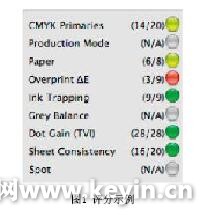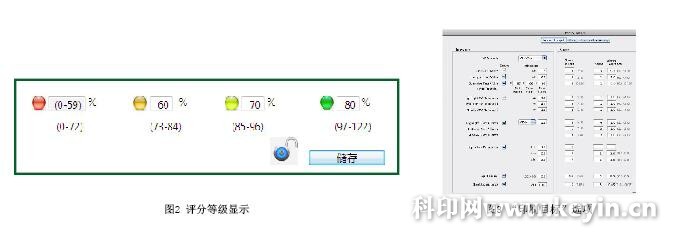Quotation
As more and more print buyers enter the standardized and digital track, printers have to follow, especially in the coastal areas to undertake orders for overseas European and American printing, including through GMI (International Graphic Measurement) certification. Printing companies are almost always accustomed to using the UK's Bodoni Systems' PressSIGN software to digitally evaluate printed sheets with manual or automated color scanners. A high-scoring PressSIGN report will allow print buyers to praise the quality of the prints, and sign the rewards. A PressSIGN report that fails or prompts the alarm will make the print buyers frequent their foreheads and complain about disappointment. The printing buyer refused to accept the entire batch of orders and the printing factory had to reprint it, even directly affecting the future business.
However, the very unsatisfactory reality is that according to the author's visit, many printers only stay on the basic level of applying PressSIGN for daily homework scoring, but they don't understand how the scores come from. How can I get high scores? Therefore, the author wrote a more detailed explanation of this, I hope that colleagues can not only get high scores, but also can actually improve the printing quality.
Problem solving
1. Grading mechanism
PressSIGN is a printing evaluation system for mainstream applications in China. The score is not based on the traditional Chinese system of percentage points, but is based on the percentage of the project. This is also the usual scoring rule for European study exams. Take Figure 1 as an example: There are 6 projects (CMYK Primaries, Paper, OverprintΔE, Ink Trapping, Dot Gain (TVI), Sheet Consistency) to participate in the score, the total score is 94 points, the current measurement score is 76 points, and finally The score is the ratio of the current measured score to the total score, which is 81% after rounding. Some of these projects show “N/Aâ€, indicating that the project is not involved in the assessment. Therefore, sometimes the overall score exceeds 100 points, and sometimes the overall score is less than 100 points, but the final percentage score can be obtained by calculating the weight, depending on the number of items and the distribution of scores.

When there is a spot color item, the spot color and the four colors separately participate in the scoring. The spot color score is only the percentage of the measurement score of the spot color single item and the target total score of the single item; the four color score is the item other than the spot color. The percentage of the measured score and the target total score. The final total score is still the percentage of the measured score and the target total score for all participating calculations.
The project scores in PressSIGN are divided into 4 levels, which are marked by 4 colors of red, orange, light green and dark green. Users can adjust the score range of each mark by themselves, as shown in Figure 2. Normally, if the score of the test item is red under 59%, the period is 60% to 69%, yellow, 70% to 79% is light green, and 80% to 100% is dark green.
2. Rating basis
Scores and deductions must have a standard as a reference and basis, whether it is an international standard or a custom standard. In general, the international offset standard ISO 12647-2 is currently widely recognized.
Specifically, the operator not only needs to know the difference and application of the black bottom measurement and the white background measurement, but also can distinguish the several papers specified by the ISO, understand the difference between the M0 and M1 measurement modes, and understand the difference between the new and old versions of the ISO 12647 standard. It is even necessary to know whether or not to use a target value offset calculation with respect to standard paper for non-standard paper. Therefore, if you really want to use PressSIGN, an ISO 12647 standard training course is essential.

However, many printers using PressSIGN will only use the default ISO 12647 Coated Black Backing V6 as the sole basis, regardless of whether they are using the X-Rite track scanner or the i1 Pro 2 for scanning. Single-sided printing or double-sided printing, even more disregarding the use of significantly yellow paper or gray-white cardboard. How can such a “one size fits all†reference standard easily get a high score? How can it effectively control the print quality through such a score?
3. Scoring elements
In general, a PressSIGN job rating factor includes solid density, paper, overprint (rate), gray balance, dot gain, uniformity, and spot colors. If you want to get the ideal score, each sub-project must achieve the goal.
In the "Print Target" option of Figure 3, "Tolerance and Rating" defines the sub-items to be scored, and assigns the corresponding latitude and score. The system will automatically calculate the final total score and convert it into a percentage system.
This process is similar to a test paper. The first question is to specify the question type, which is a multiple choice question, a judgment question, a fill-in-the-blank question or a question-and-answer question. Secondly, how many points each question has, how to score and deduct points, The score is the sum of the scores for each question.
Breaking the problem
1. Target definition
First of all, it must be clear whether the ISO 12647 standard uses the new version (2013 version) or the old version (2007 version). Because each standard specifies different paper types, it must be correctly selected according to current conditions. In general, due to instrument limitations and customer needs, the current ISO 12647 standard is still relatively common.
Second, the paper type must be clarified. The broad categories of paper are generally classified into Coated (coated paper) and Uncoated (uncoated paper). Be careful to select the type of the current paper. Never use the coated paper's signature file to measure uncoated paper. In addition, many papers do not fully comply with the ISO 12647 standard paper. In actual operation, only paper that meets the requirements of ISO 12647 can be selected. If you encounter a specific paper, in order to be more realistic, you must make a custom modification based on the original standard, or define a new evaluation target by importing measurement data or feature files.
2. Measuring the backing (backing)
That is, the material placed on the back of the sheet when measuring, usually including white lining WB or black lining BB. The ISO 12647-5 standard also has clear requirements for measuring the whiteness and blackness of the backing. In actual operation, if it is single-sided printing, depending on the thickness of the paper, a number of blank printed sheets of the same material are usually used as the measurement backing. In the case of double-sided printing, the black lining is more useful, providing a more consistent reading, avoiding the color of the printed color strips or the text on the back of the sheet to affect the consistency of the front color measurement. Be careful not to place one sheet directly on top of another.
Because measuring instruments and measuring papers are not the same, measuring the backing needs to be properly selected. In general, ordinary manual scanners such as i1 Pro 2 are white-lined, orbital scanners such as IntelliTrax are black-lined; single-sided printed sheets are white-lined, and double-sided printed sheets are mostly black-lined.
3. The ink is wet and dry
The same sheet, measuring instrument and software settings, the measurement scores just before the printout and the inspection are very different, it is probably because the ink is wet and dry. PressSIGN is able to calculate changes in color and density in measurements between wet and dry sheets. First measure a wet sheet and then measure the same sheet after 24 hours or enough sheet drying time (or measure multiple sheets to average) and PressSIGN to convert the ink dry and wet data. It is important to note that creating dry information for ink and paper is done in two separate jobs.
4. Relative paper
In general, the paper color in the signature file is different from the paper color used in the bulk printing. In this case, you can either enter a new paper Lab value or directly measure the paper white, similar to creating a new standard based on the color of the paper different from the one used to create the signature file. It is more common to select the paper specified by the ISO 12647 standard that is most similar to the current paper, and then check the “Target CMYK Lab value is adjusted according to the paper whiteâ€, so that all target value data will be biased with reference to the existing paper white. The shift calculation is similar to the relative G7 in the G7 method.
5. Field density
CMYK is the main factor of scoring in the field. The target value of CMYK is the standard. If any ΔEab value is larger than the tolerance range, it will be displayed in red, indicating that it will lose points. If the ΔEab value is displayed in black, the color is in the capacity. Within the range of the difference, the score will be scored. In fact, the right-matched density value and ΔEab value are clearly indicated on the right side of each color. If CMYK cannot be reached to the target Lab value (International Standard ΔEab is 5), be aware of the correct target standards, measurement backing, paper, and ink. It should be noted that before any adjustment of the TVI (tonal value increase) is made, it is necessary to ensure that the CMYK solid color value is within the tolerance range, otherwise it is futile.

Oval Shape Plate,Melamine Oval Plate,Oval Dish Plate
Nanjing Demei Melamine Wares Co.,Ltd , https://www.dm-melaminewares.com